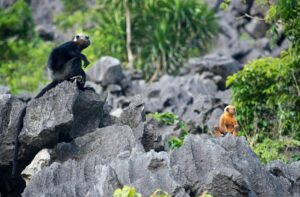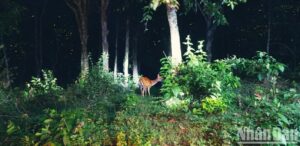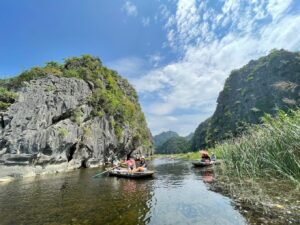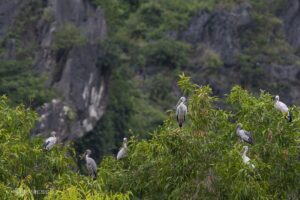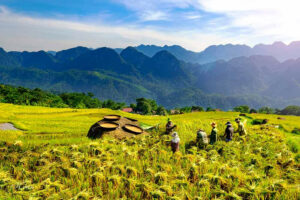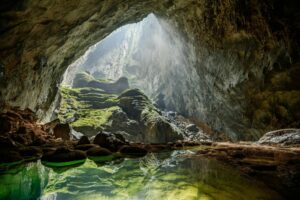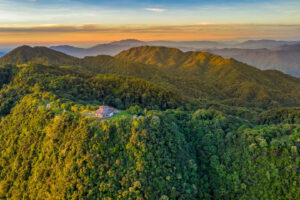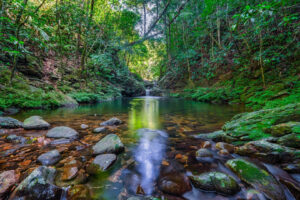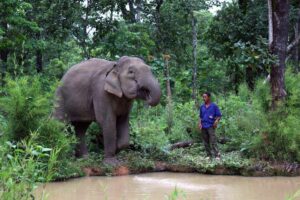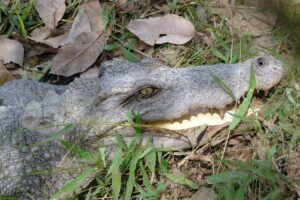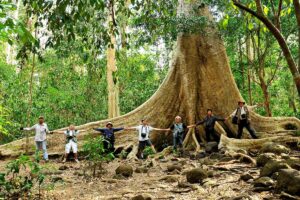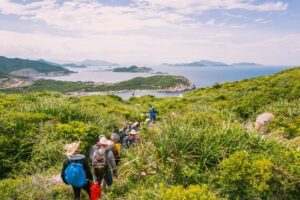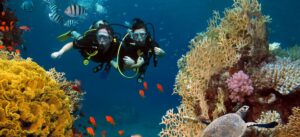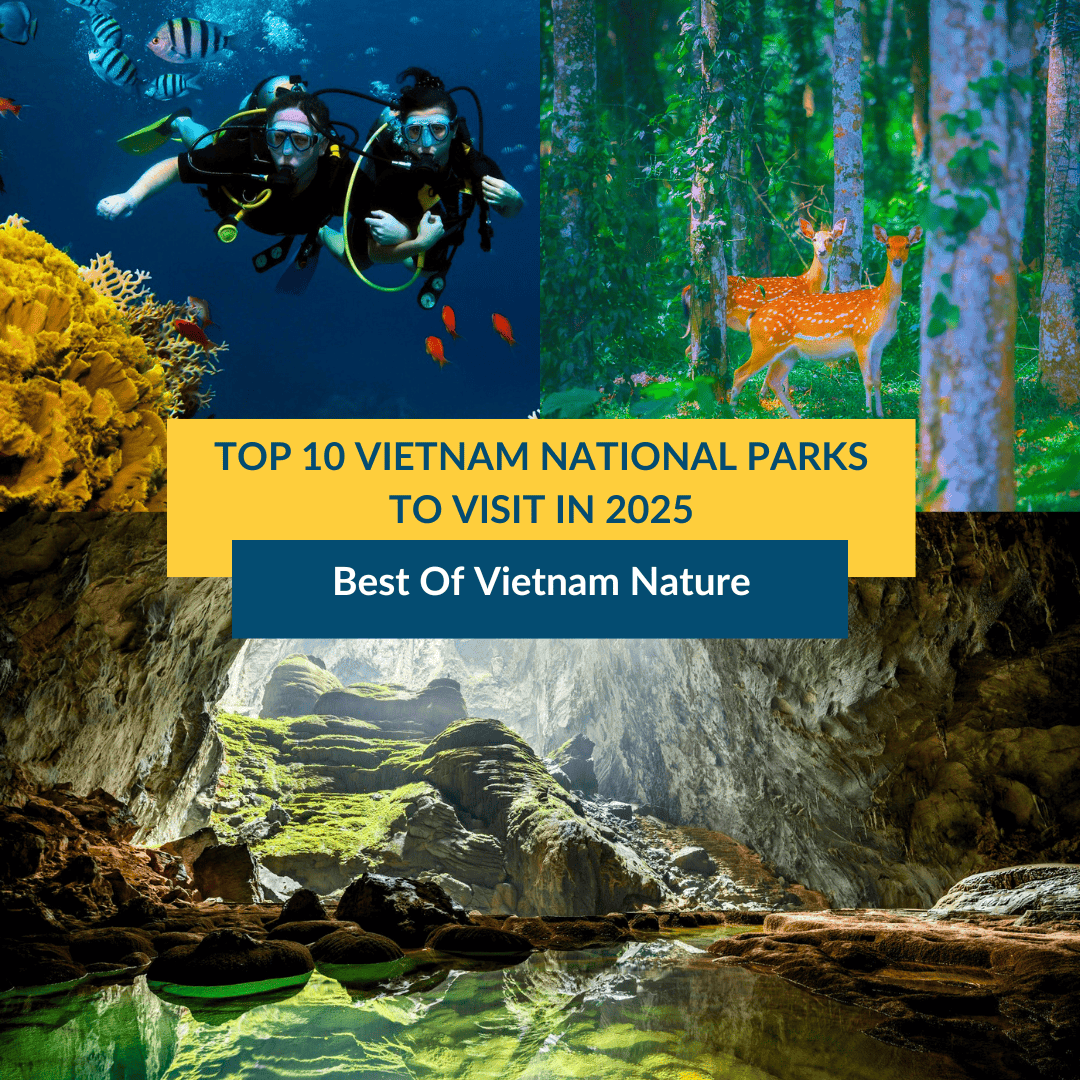
Best of Vietnam Nature: Top 10 Vietnam National Parks To Visit In 2025
Vietnam nature is remarkably diverse and beautiful, making it a haven for nature enthusiasts. Its varied landscapes, spanning from the lush mountainous north to the fertile southern plains, results in diverse climates, terrains, ecosystems, and ethnic communities. Let’s discover Prime Travel‘s 10 recommended Vietnam national parks to visit in 2025.
Overview of Vietnam Nature
There are total 33 Vietnam national parks (see full list), spanning the entire length of the country. However, urbanization, agriculture, logging, and illegal hunting have severely diminished habitats for numerous species, including elephants, tigers, bears, and primates, leading to local extinctions and endangered status.
Traditional beliefs and superstitions, particularly regarding the supposed medicinal value of certain animals, further add to the problem and threaten Vietnam nature and biodiversity.
Despite these challenges, Vietnam has taken steps in conversation, beginning with President Ho Chi Minh’s designation of Cuc Phuong as the nation’s first national park in 1960, during the Vietnam War.
Today, these protected areas are closely monitored, and many feature rescue centers dedicated to rehabilitating illegally captured or domesticated animals for eventual release back into the wild.
These national parks are crucial for preserving Vietnam’s rich biodiversity. They provide vital sanctuaries for endangered species, safeguard unique ecosystems, and offer essential ecological services. Furthermore, they serve as centers for research, ecotourism, and education, raising environmental awareness among both locals and visitors.
Top 10 Vietnam National Parks To Visit In 2025
Cat Ba National Park
As one of the best Vietnam national parks, Cat Ba is a famous tourist destination in Hai Phong for those seeking to discover Vietnam nature. Cat Ba National Park, located at the core of the UNESCO Cat Ba Archipelago Biosphere Reserve in Hai Phong Province, encompasses 17,363 hectares, including both land (10,912.51 ha) and sea (6,450.45 ha).
The park shares the stunning karst scenery, pristine beaches, and diverse ecosystems characteristic of Ha Long Bay. Home to over 1,500 plant and 282 animal species, notably the endangered Cat Ba langur, the park’s landscape features dramatic limestone cliffs, hidden caves, and vibrant lagoons.
Cat Ba National Park plays a crucial role in biodiversity conservation and sustainable development. Visitors can marvel at Vietnam nature when partaking in various activities such as hiking, rock climbing, kayaking, snorkeling, swimming, and wildlife spotting, with the chance to see rare animals like the Cat Ba langur.
Cuc Phuong National Park
Cuc Phuong is not only one of the best Vietnam national parks but it is also the oldest. This park, located in Ninh Binh Province, spans 22,408 hectares and boasts incredible biodiversity.
With the characteristic of a tropical rainforest, green all year round, Cuc Phuong has 2234 species of higher plants and moss, of which 433 species are medicinal plants, 229 species are edible plants, and many species are recorded in the Red Book of Vietnam.
Cuc Phuong National Park is home to a diverse range of animals, including 122 species of reptiles and amphibians, 66 species of fish, nearly 2,000 species of insects, and 135 species of mammals. Among these mammals is the critically endangered and beautiful Delacour’s langur, which has been chosen as the symbol of Cuc Phuong National Park. With 336 resident bird species, including many endemic to Vietnam and Indochina, Cuc Phuong has long been an ideal destination for birdwatchers.
Cuc Phuong has many beautiful caves Son Cung Cave, Pho Ma Giang Cave… In particular, some caves still preserve traces of prehistoric people, who lived from 7,500 to 12,000 years ago, such as Dang Cave (Cave of Ancient People), Con Moong Cave.
Visitors can enjoy hiking trails, exploring caves and ancient trees, biking, birdwatching, and participating in educational programs focused on conservation and local biodiversity (Primates, turtles, carnivores and pangolins, ungulate and bird conservation areas).
Van Long Wetland Natural Reserve
Van Long, one of the largest wetlands in the Red River Delta and Vietnam’s 9th Ramsar site, boasts abundant natural resources and a unique ecosystem. This biodiverse area, featuring a limestone mountain ecosystem, is home to the world’s largest population of the endangered Delacour’s langur.
Thousands of plant and animal species thrive here. Van Long Forest alone contains 457 higher plant species, including eight listed in Vietnam’s Red Book. Notely, Van Long feaetures numerous bird species, such as kingfishers, herons, egrets, and rare species like Asian openbill storks, Northern pintails, Eurasian coots, and White-browed crakes.
The presence of the rare bug – “Cà Cuống” (Lethocerus indicus) indicates the pristine quality of the water and surrounding environment. Van Long also features 32 stunning caves, including several notable ones like Fish, Shadow, Turtle, and Chanh Caves.
A boat trip on Van Long Lake offers a tranquil escape into the beauty of Vietnam nature. Drifting across the serene waters, visitors are enveloped by dramatic limestone mountains and vibrant greenery. This visually stunning experience provides a peaceful respite from daily life, allowing for relaxation amidst the gentle sounds of the water and refreshing breezes.
Pu Luong Natural Reserve
Although officially a national reserve, not a park, Pu Luong’s breathtaking scenery of mountains, rice terraces, jungles, and waterfalls earns it a spot among Vietnam’s top natural destinations. Often compared to Sapa, but smaller, Pu Luong offers a similar experience with added charm from the Muong and Thai ethnic villages nestled amongst the iconic terraced rice paddies.
Rich in biodiversity, Pu Luong Natural Reserve features dense tropical rainforests with over 1,100 plant species, including several significant primary forest subtypes.
The reserve also harbors a diverse animal population, including 84 mammal species (24 of which are bats), 162 bird species, 55 fish species, 28 reptile species, 13 amphibian species, 158 butterfly species, and 96 land snail species, with 12 potentially unique to the area. Notably, Pu Luong is a crucial habitat for the critically endangered Delacour’s Leaf Monkey.
Summer is an ideal time to visit for a cool escape, while the harvest seasons (May-June and September-October) offer stunning golden landscapes. Exploring the beauty of Vietnam nature is best done through trekking, cycling, or motorbiking. From hiking to the peak of Pu Luong Mountain to multi-day adventures across the reserve, thrilling experiences are guaranteed.
Another highlight of visiting Pu Luong is staying in one of the many charming and atmospheric homestays or resorts nestled within the reserve. Explore our blog Top Things To Do In Pu Luong Nature Reserve – The Ultimate Guide 2025 for more information.
Phong Nha – Ke Bang National Park
Phong Nha-Ke Bang, a UNESCO World Heritage Site in Quang Binh Province and considered one of the best Vietnam national parks, is a haven for adventurers. Spanning 123,326 hectares, it offers both stunning above-ground scenery, with jungles, mountains, and rivers, and an incredible underground world, featuring some of the world’s largest and most impressive caves.
The park’s diverse ecosystems support over 2,700 plant species, 200 bird species, and 154 mammal species. Its karst landscape and cave systems, including Son Doong and Phong Nha Caves, are adorned with magnificent formations.
Visitors can explore the caves with guided tours (like those offered by Oxalis Adventure), trek through lush forests, swim in pristine rivers, zip-line, and spot wildlife, including rare species like the Hatinh langur. Eco-friendly accommodations like Tu Lan Lodge allow visitors to immerse themselves in the park’s beauty while supporting local communities and conservation.
Phong Nha-Ke Bang National Park truly highlights the beauty of Vietnam nature with immersive experiences, whether you prefer a peaceful cave walk or a challenging two-day jungle trek with cave climbing and rappelling.
Bach Ma National Park
Tucked away near Vietnam’s central coast, west of Hue, Bach Ma National Park offers a glimpse into pristine Vietnam nature. Its jungles conceal remnants of French villas, while waterfalls and mountain peaks provide stunning vistas. This 37,487-hectare park boasts diverse landscapes, from tropical rainforests to mountain summits.
Bach Ma is home to over 2,000 plant species, 1,029 insect species, and 363 bird species, as well as rugged mountains, cascading waterfalls, and pristine rivers. Designated an ASEAN Heritage Park in 2022, it’s also the only known breeding ground for the critically endangered saola or Asian unicorn.
Visitors can enjoy hiking, birdwatching, swimming in natural pools, and guided tours to historical sites like the Bach Ma Summit and Hai Vong Dai observation tower. However, the rainy season (September to December) makes Bach Ma’s rugged trails difficult and potentially dangerous to hike.
Yok Don National Park
Yok Don, the second largest Vietnam national Parks after Phong Nha-Ke Bang, is renowned for its elephant species. Located in the Central Highlands, this 115,545-hectare park spans Dak Lak and Dak Nong provinces.
Historically, elephants were used extensively for labor and tourism (elephant riding tour) in this region, but thankfully, many of the remaining elephants have been released back into the wild within Yok Don.
The park’s landscape features vast pristine forests, grasslands, and wetlands, supporting over 1,000 plant species, 300 bird species, and 90 mammal species, including endangered Indochinese tigers and Asian elephants.
Ancient volcanic mountains, winding rivers, and seasonal floodplains create diverse habitats. As the only park dedicated to preserving Vietnam’s dry deciduous dipterocarp forests, Yok Don offers visitors opportunities for hiking, wildlife viewing, learning about local ethnic minority traditions, and ethical elephant experiences.
Cat Tien National Park
As one of Vietnam’s largest national parks, covering 71.187,9 hectare in Dong Nai Province, Cat Tien protects a unique mix of tropical rainforests, wetlands, and floodplains. Its impressive biodiversity includes over 1,700 plant and 700 animal species, such as the critically endangered Javan rhinoceros and Siamese crocodile.
For a small entrance fee, visitors can explore well-marked trails or rent bicycles and other transportation. A highlight is the Ramsar-recognized Bau Sau wetland, 15km into the reserve, home to hundreds of endangered crocodiles, including the critically endangered Siamese crocodile.
Deeper within the park, visitors can marvel at the 500-year-old Tetrameles nudiflora tree, a symbol of Cat Tien, and numerous waterfalls (Troi, Ben Cu, Mo Vet) perfect for kayaking or swimming. The dry season (December to May) is ideal for trekking and butterfly watching.
Visitors can also marvel Vietnam nature by taking part in wildlife spotting and guided night safaris, and visits to conservation centers like the Endangered Primate Rescue Center.
Nui Chua National Park
Nui Chua National Park, a leading nature conservation area in Vietnam, is located on the coast of Ninh Thuan province, about 350km from Ho Chi Minh City. This park, situated within the mountainous promontory of Nui Chua, was designated a UNESCO Biosphere Reserve in 2021, recognizing its exceptional and largely untouched biodiversity.
Covering over 30,000 hectares, the reserve rises to over 1,000 meters at its peak, Co Tuy, before descending to the South China Sea. It protects both marine biodiversity, including sea turtle nesting beaches and over 350 delicate coral species, and a remarkable 20,000 hectares of pristine forests, teeming with diverse flora and fauna.
Ninh Thuan’s characteristically dry, sunny climate, with the lowest rainfall in south-central Vietnam, creates a unique semi-arid landscape and coastal environment. Due to the year-round heat and dryness, trekking can be challenging.
A visit from late August to September offers a respite from the extreme temperatures. A two-day trek along the popular Da Hang Hamlet – Lo O Stream trail provides a less crowded, more peaceful experience, allowing visitors to explore the rich culture and traditions of the Raglai ethnic people.
Con Dao National Park
Con Dao, a 16-island archipelago once known for its prisons during both French colonial rule and the Vietnam War, has become a breathtaking destination and Vietnam’s top diving spot. Nearly 20,000 hectares are protected within Con Dao National Park, a biodiversity hotspot with over 1,000 plant species, 150 terrestrial animal species, and more than 1,700 marine species, including rare and endemic species like the critically endangered Con Dao black squirrel and the globally threatened hawksbill turtle.
Much of the archipelago is a National Marine Park, preserving its vibrant underwater world. Con Dao’s crystal-clear waters and ideal diving depths (5-10 meters) make exploring its diverse coral reefs an unforgettable experience.
The islands’ protected forests also offer excellent, often solitary, trekking, leading to pristine, secluded beaches where visitors might witness nesting turtles. A must-do experience on Con Dao is observing these turtles laying eggs, best experienced during the peak breeding season from July to September.
Pro Tips to Know Before Visiting Vietnam National Parks
- Book permits and tours in advance: Some parks require permits, especially for overnight stays or specific trails. Popular parks and tours, particularly during peak season, can book up quickly. Research and book ahead.
- Check the weather: Vietnam’s weather can be unpredictable. Check the weather forecast before visiting for your chosen park and activity, considering rainy seasons, heat, and potential storms. Pack accordingly.
- Transportation: Consider how you’ll get to and around the park. Transportation options vary and may include buses, taxis, private cars, motorbikes, or even boats. Factor in travel time, especially for remote locations.
- Accommodation: Research accommodation options within or near the park. Choices may range from basic guesthouse to comfortable eco-lodges. Book in advance, especially during peak season.
- Pack appropriately: Essential items include comfortable hiking shoes, insect repellent, sunscreen, a hat, rain gear, a reusable water bottle, and a first-aid kit. Consider packing binoculars for wildlife viewing.
- Learn some basic Vietnamese phrases: English proficiency in Vietnam national parks can be litmit, knowing a few basic phrases can enhance your experience and interactions with locals.
- Respect local customs and environments: Be mindful of local customs and environments, especially when visiting ethnic minority villages within or near national parks. Dress modestly and ask permission before taking photos of people.
FAQ About Vietnam Nature
Which part of Vietnam has the best nature?
- For mountains and rice terraces: The mountainous North, Pu Luong Nature Reserve, is renowned for its stunning landscapes.
- For beaches and islands: The Central and Southern coasts offer beautiful beaches, with islands like Nui Chua, Con Dao being popular choices.
- For caves and karst landscapes: Phong Nha-Ke Bang National Park in Central Vietnam is a must-see for its incredible cave systems.
- For biodiversity and wildlife: Cat Tien National Park in the South and Cuc Phuong National Park in the North are excellent choices for wildlife viewing.
Ultimately, the “best” part of Vietnam for nature depends on your personal preferences. Research different regions and parks to find what appeals to you most.
What is the oldest national park in Vietnam?
Cuc Phuong National Park is the oldest Vietnam national park
What is the biggest national park in Vietnam?
Phong Nha Ke Bang National park is the biggest Vietnam national park
From towering mountains and verdant forests to stunning coastlines and captivating islands, Vietnam nature is remarkably diverse. The Vietnam national parks serve as prime examples of this breathtaking beauty and showcase the rich biodiversity that makes Vietnam a truly special destination for nature lovers.


